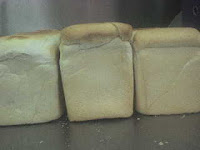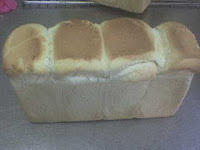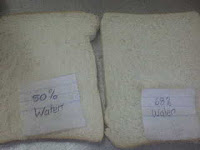The effect of water on a final product will be identified by producing one product with insufficient water (50%) and another with excess water (68%). These doughs will be compared against a perfect loaf (60% water).
Activity
Calculate each of these white doughs
Dough 1: 60% water
Dough 2: 50% water
Dough 3: 68% water
Dough Recipes
Dough 1
Bakers Flour………100%
Salt………………….2%
Improver……………1%
Canola Oil…………..1%
Yeast……………….3%
Water………………..60%
EYF…………………1.67
Dough 2
Bakers Flour………100%
Salt………………….2%
Improver……………1%
Canola Oil…………..1%
Yeast……………….0%
Water………………..50%
EYF…………………1.54
Dough 3
Bakers Flour………100%
Salt………………….2%
Improver……………1%
Canola Oil…………..1%
Yeast……………….6%
Water………………..68%
EYF…………………1.78
Each dough was produced using the same water temp, mixing time, proof time and baking time as the perfect loaf. The only alterations to the doughs were the water levels.
Each dough was a 4kg dough therefore the correct recipe was
Dough1
Bakers Flour……….4.00kg
Salt………………..0.08kg
Improver……………0.04kg
Canola Oil…………0.4kg
Yeast………………..0.08kg
Water……………….2.4kg
Doughs 2 and 3 were the same but for the water levels, i.e.
Dough 2-Water……….2.00kg
Dough 3-Water………2.72kg
Results
Each dough was removed from the bowl at 28 degrees Celsius. Each dough then was given 20mins intermediate proof time before being moulded in 4 piece blocks. Afterwards were placed into the prover. Dough 1 was proved for 1hour 5mins before being placed into the oven. Dough 2 and 3 were given approx. 50mins to 1 hour prover time. Each dough was baked for 220 degrees for 28 mins.
Dough1 Correct Recipe (Perfect Loaf)
The first pictures below are of the perfect loaf, from the time it was moulded from the bowl. The following pictures from then are of the final baked product externally and internally.
External Results
Loaf Volume(Size)- Good quality of volume, perfect size, will be easily packaged and sliced. Normal volume aspects. Water is a basic ingredient in bread baking. It would be impossible to produce a loaf of bread without water in some form and therefore there would be no volume without water.
Crust Colour- Lightly baked brown colour, perfectly desired colour, and nice glossy type shine.
Oven Spring- As can be seen from the pictures the loaf was placed into the oven just below the tins top, and sprung roughly a quarter in size as it baked.
Crust Character- Perfect crust character, with shiny coat, nice soft texture with regular shape and even grain.
Internal Results
Crumb Colour- Neither pale nor dark, perfectly white.
Crumb Softness- Perfect moist centre, not to dense or tough. Perfectly baked causing no doughyness, or poor strength.
Crumb Evenness- Even thickness, perfected even grain. Regular shaped, and regular sized cells.
Aroma- perfect fresh smell, not yeasty, bland, sour nor salty.
Dough 2 Insufficient Water
The following after a normal loaf are pictures of Dough 2 with insufficient water (50% instead of 60% water), the first picture is of the dough in the bowl showing the increased amount of strength and result of the lack of water within the dough before the oil was added. The next picture is of the dough moulded up; as it can be seen the dough began to tear, as with the next picture the dough after being through the final moulding process and four pieced the tears throughout the dough can be seen. The following pictures from then are of the final product of the dough internally and externally and compared to a normal loaf. (The loaf on the left is the loaf with 50% water). This dough spun in the bowl for almost half an hour before reaching 28 degrees.
External Results
Loaf Volume (Size) - There was an increase in volume in comparison to the perfect loaf, but in weight terms the perfect loaf weighed more than this loaf, with 50% water, without water, gluten does not exhibit its pliable and elastic characteristics, which the baker utilises for gas retention and dough volume.
Crust Colour- A darker brown colour compared to the perfect loaf (which can be clearly seen within the pictures), patches of higher resolution of colour present throughout the loaf, the crust colour is more thoroughly coloured than the perfect loaf.
Oven Spring- Higher oven spring compared to the perfect loaf, (can be seen in pictures).
Crust Character- The top of the loaf is rounded, the 4 square sections on the four pieced loaf are rounded also instead of being squared like the perfect loaf, the surface had bubbles, and is torn and ragged, the loaf is too thick.
Internal Results
Crumb Colour- Lighter compared to the perfect loaf, pale but not as pale as a dough with 68% water.
Crumb Softness- The loaf was too thick, and so resulted in a thick softness, it was harder than the perfect loaf. This loafs shelf life would not be very long.
Crumb Evenness- Too compact, uneven irregular shape, Poor strength in means of tightness, very dense.
Aroma- Almost identical to the perfect loaf, the smell was a bit stronger, due to the increased friction of more flour inconjuction with lesser water within the dough.
Dough 3 Excess Water
The next lot of pictures of are the dough with excess water, 68% water instead of the standard 60%, starting from the dough at 28 degrees within the bowl, followed by the final product, and then by the internal and external pictures. Also included are this dough in comparison with a dough with 50% water. And below these pictures are pictures of all three doughs, to determine a final comparison view. This dough spun for only 10mins before reaching 28 degrees.
External Results
Loaf Volume(Size)- larger in volume due to an excessive more amount of water within the dough compared to the perfect loaf.
Crust Colour- Very Pale, lesser colour present within the loaf, as can be seen in the pictures.
Oven Spring- regular oven spring, dough proved misshapen.
Crust Character- tough/leathery, side and ends were misshapen, loaf was very fragile, had a crowned top present.
Internal Results
Crumb Colour- Very Pale, from the three doughs mixed, this loaf with 68% Water was the lightest in colour.
Crumb Softness- Very soft and fragile, a finger could easily be pushed through a sliced piece, loaf separated and became difficult to manage when sliced. Poor strength.
Crumb Evenness- open coarse texture, holes within the loaf present, poor strength in mean of softness, sticky, unevenly developed.
Aroma- slightly unbaked smell present, due to excess water present.


............................................................................................................................................................


............................................................................................................................................................
.........................................................................................................................................................
 Loaf on left is loaf with 68% water, middle loaf is loaf with 50% water and right loaf is 60% water.
Loaf on left is loaf with 68% water, middle loaf is loaf with 50% water and right loaf is 60% water. 





























No comments:
Post a Comment